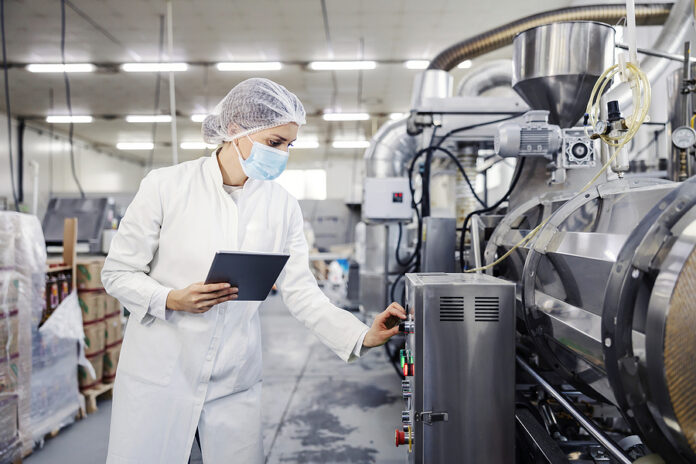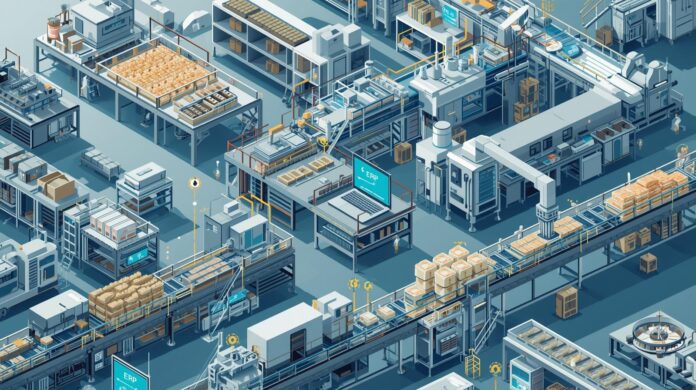

At this year’s EATS show, we sat down with Mike Burica, Chief Commercial Officer at WorkForge, an eLearning software company that helps food manufacturers convert workforce development into tangible business gains by improving retention, performance, and adaptability through smarter training and culture building.
Our conversation centers on culture as an operating system: how executives create trust on the floor, capture institutional knowledge before it walks out the door, and translate learning into throughput. Burica shares how to move from event-based training to continuous skill building and why data-informed development should sit alongside automation in every productivity plan.
Q. EATS brings together leaders from across the food manufacturing world. What conversations are you most excited to have, and what’s top of mind for the executives you’re meeting with?
Mike Burica: The most interesting thing about these events is hearing from the customers and understanding their labor force challenges.
They’re currently navigating a dynamic situation due to federal regulations. One thing we’re hearing about is the impact of ICE, how they’re training their workforce to deal with those events when they happen, and how they’re keeping their workforce safe.
We’re also having conversations about how they’re attracting workers, how they’re retaining those workers, and how they’re preserving knowledge from the retiring workforce. The proverbial term everybody’s using now is “the silver tsunami” — nearly half of the manufacturing workforce is now 45 or older, so they’re in that retirement bucket.
Q. Are you sensing a shift toward longer-term workforce strategy instead of short-term hiring fixes?
MB: We’re seeing both, but the ones who are making legitimate progress are starting to look at their workforce data in its rawest form using tools — whether that be things that they’ve homegrown, third party tools, or AI. And what many of them are finding is a direct correlation between training and retention.
There’s a large pet food manufacturer that found that if they can keep an employee in their first year, the probability that they’ll have them for three years increases 200%. And if they have them at three years, they’re more likely to have them at five. And if they have them at five, they have them for life. So it’s critically important to get the first year right because it has a powerful ripple effect.
Q. Every manufacturer says workforce is their biggest challenge. What’s the biggest misconception about how to actually fix it?
MB: It’s at the executive level, where their challenges are very dynamic. Every day there’s something different, whether it’s production, labor, federal regulations, or pressure from the investment community and shareholders. Training has always been an afterthought, when it should be the foundation.
When you walk across a modern floor, you’re surrounded by impressive equipment and automation, but there’s still a great deal of human interaction on that line. In baking, you get more automation, but when you move into protein, it’s still labor intensive. So it’s critical to build a relationship with that labor force.
Employees can always move to a factory where they can earn more, and you’ll end up with this transactional and transitional workforce. So you have to build a relationship with that individual and show them that you care about them.
We talk about the three components of trust:
- The first is trust that you’re going to keep them safe. They’re working with dangerous machines with fast moving and heavy parts. So you’re going to teach them how to interact and operate that equipment.
- Second, you’re going to help them do the job they were hired to do. They’ll walk out at the end of the day with a sense of accomplishment, feeling like they’ve done something productive.
- Thirdly, trust that you will give them the opportunity to learn and advance their career path in a way that’s tailored to where they want to move, whether that be maintenance, sanitation, or leadership.
Q. Do you think leaders underestimate the impact of management behavior on retention and performance?
MB: Everybody is aware of it. The question is, is it the thing that they’re going to focus on? And when, as with large publicly traded companies, shareholders have certain expectations, it draws you back to a different lens.
But there are some companies that are doing it better than others. A company may already do well with training and engaging their employees, but they may not do it efficiently. And that’s where technology comes in.
Q. Training has historically been viewed as a cost. You’ve made the case that it’s one of the fastest ways to move the P&L. What results or success stories best demonstrate that shift?
MB: I’m going to give a little preamble before I answer that question. It’s the flip of training from a compliance perspective to training for a competency perspective. And when you’re competent, you bring in ideas like critical thinking. You can sense when things are and aren’t working well, you can raise that up to a frontline supervisor, and you can make adjustments and drive change. When you have that foundation, you’re able to drive efficiencies.
There are a couple areas where companies can differentiate themselves. One is the way they onboard. It’s not sitting in a classroom for a week and having a bunch of information thrown at you; it’s that ability to take that learning and draw it out over a period of time. One organization that we’re working with calls it job hardening. What was five days in a classroom of just being talked at or having instruction given to you is now a half a day. And you are brought out onto the floor in an observatory role. The next day you get to do a little bit of hands-on. Then there’s going to be more training in that second week. So you’re driving efficiency within the organization. You’re driving engagement, and hopefully you’re driving retention.
One other idea I’ll share is a really specific example from a large beef producer. They were able to reduce year-over-year maintenance tickets by 70% by providing basic maintenance training to their frontline operator. Lines didn’t go down while waiting 15 or 30 minutes for that maintenance worker to come over and flip a switch, unclog a jam, or something very simple in the grand scheme of things. That has allowed them to have OEE, increase yield, and hire fewer maintenance workers.
Q. Are companies measuring the impact on safety, quality, or productivity — or all three?
MB: It depends on the organization. The large organizations are starting to do that and have been doing that. And this transition and the democratization of analysis through AI is going to allow them to do more and more of that. You’re going to start to see third parties thinking about what their AI strategy is. We’re starting to see this convergence of ideas, but I think we’re years away from it being practical.
But it’s really challenging for those mid-tier and small-tier companies. It’s critical for them because they’re so dependent on that workforce. And they’re not there yet, so we need to help bring them along.
Q. You talk about empowering workers from hire to retire. What does that lifecycle look like in a modern food plant — and where do most companies still fall short?
MB: I see three areas where companies are missing the mark: you have the onboarding, the productivity years, and the offboarding years. Everything today is in that onboarding phase, and it’s all about compliance. “Did we send you through the appropriate training so when the auditors come through we can check the box?” Again, our approach is to think of them as individuals, not just part of the whole. How are you going to build that relationship?
One of the things that we have in our training is financial literacy. Sometimes these individuals are new to our country, or maybe they have a GED. Have they ever received a check before? Then once you move them onto the floor and things evolve, how are you keeping them up to speed? How are you continuing to reinforce good manufacturing processes? How are you developing them? How are you offering up new opportunities and new paths for them?
Lastly, and this is probably the biggest miss, the most senior people in the organization are walking out the door with 30+ years of knowledge and you’ve done nothing to document or retain that.
The offering that we’ve built over the last few years provides the ability to do all of those things. We can provide off-the-shelf training and the learning management system (LMS) to deliver that. We can do custom training that takes specific knowledge (the intellectual property of that organization), retains it, and brings it back into their general day-to-day training.
Q. How can digital tools help make learning continuous rather than one-and-done?
MB: Our LMS is specifically built for manufacturing — not just for compliance, but building a curated learning path over a lifetime of employment for each individual. It’s an opportunity to serve up both technical aspects, as well as soft skills, communication, conflict resolution, and things of that nature. As they become technically competent in the role, you can continue to build them up as an individual.
So we don’t look at it as just for those five days or 30 days. We’re working with our HR and our learning development partners to build job paths that will take them over many, many years.
Q. Automation and workforce development are often seen as competing priorities. How does smarter training make automation more effective — and less intimidating?
MB: Where you start to leverage technology and AI is the ability to create better content for employees. As I mentioned earlier, for many of the people who are filling these roles, English is a second language, or it may not even be a language that they speak. So how are you translating your learning content for them?
Haitian Creole has all of sudden become a huge employment population in Ohio and in Pennsylvania, but that’s not a language that many organizations have content in. We can use technology to help create that content in both spoken and written word.
You can use technology to break down a machine in a 3D fashion so that when you maintain or clean it, you can see all of the little components that need to come out and how to break it down. And you can deliver that practical learning just in time. Sure, you hope they will go through a formal training on a piece of equipment at some point. But with the help of technology, the first time they’ve interacted with that machine is not when they’re out on the floor, but in a safe environment like a break room or a training room. They have an opportunity to play with it, understand it, configure it, and work with the parameters.
When they move out onto the floor, you can put a QR code on that piece of machinery that serves up bite-sized pieces of training about how to make parameter changes if something isn’t working right. It goes back to building confidence and trust in that employee.
Q. Do you see this convergence — people and machines — changing how leaders think about skill development?
MB: Here’s a practical example where I’ve seen technology and equipment allow people to do more value-added roles. There’s a large protein processor in the Omaha area with a machine on their floor that many people start on, and it’s part of the process where they have the highest turnover. It’s called the tyer, and it’s an arduous manual process for workers that can be painful and cause carpal tunnel. There is now a piece of technology that automates this, so you can move people off this painful role and train them on other parts of the process where they can add more value versus just using these elastic bands. Giving people the training to be able to move to other opportunities on the floor helps strengthen your overall frontline culture and empower your employees.
Training also provides flexibility for the manufacturers. We had a pizza manufacturer that moves people in and out of lines depending on the products being manufactured and the different lines required on any given day. Workers have to be able to move from machine to machine, so they use those QR codes for on-the-spot training. They have mobile devices on the floor they can use to scan the QR codes or access the learning content whenever they need it.
Q. For plant leaders looking to build stronger frontline cultures, what have you seen separate the best from the rest?
MB: It usually starts with a dynamic HR leader, often a new HR leader wanting to put their thumb print on it. That’s where we see a lot of traction early on. They tend to be business- and data-oriented. They don’t just want to do learning and development for the sake of learning and development, but they believe it’s going to create a competitive advantage in their ability to attract and retain employees, improve yield, and all of the things we’ve been talking about.
They then speak to a CEO, CFO, or operations leaders in very specific, tangible terms about the improvements they’re aiming for and start to deliver on them. So it’s led by a CHRO who’s bringing that C-suite along in the conversation to secure buy-in at that level. Without that, it’s really challenging to get this thing off the ground.
Q. Looking across EATS, what emerging technologies or ideas do you think will have the biggest impact on how food manufacturers attract and retain talent in the next few years?
MB: The automation on the floor and the ability to create work environments that aren’t nearly as physically demanding. As you walk around the floor, you’ll see this flip — whether it’s the way in which you are slicing, dicing, lifting, or conveying. We saw it in technology years and years ago where the people became the managers of the system. You’ll need more technically proficient people that are interacting with and programming this equipment.
We’re going to need to figure out how to serve that from a learning and development perspective. I believe it will be critical to partner with traditional education (junior colleges, vocational schools, etc.), whether you send people there or you bring them on site to augment that.
Regarding data, the industry is a little bit slower. They have a long history of doing things a certain way, but they’re starting to collect data. That next iteration of that will be what to do with that data. You’re going to need to take the data that Redzone is collecting, that WorkForge is collecting, and merge it with the organization’s HR system data. Now, whether that becomes a third party stepping up or we leave it to the organizations, I don’t know. But this convergence of data sets is what I see as the next big move.
Q. If you could leave the audience at EATS with one message, what would it be — about what it really takes to future-proof your workforce?
MB: Be intentional about it. Decide what to do and stick with it. Whether you’re Nestlé and you’re driving $3 billion out over the next 10 years or a smaller company, don’t short change learning and development. It’s an easy line item to strike when you’re going through these exercises, but it will have exponential knock-on effects in your ability to produce goods, attract revenue and investment, and innovate.
All of that is going to come from a well-trained, enabled, workforce that can empower and inform the C-suite. They’re treated and developed as core assets within an organization.

Credit: Source link



![[eBook] 2026 Food & Beverage Trend Forecast [eBook] 2026 Food & Beverage Trend Forecast](https://foodindustryexecutive.com/wp-content/uploads/2025/11/FoodIndustryExecutive-900x600px-150x150.png)









